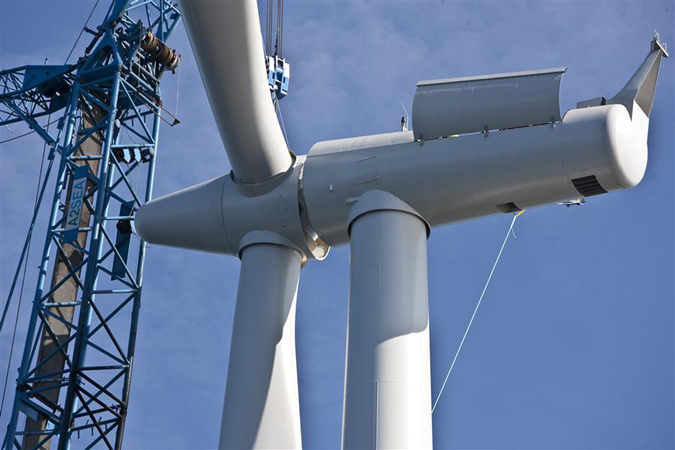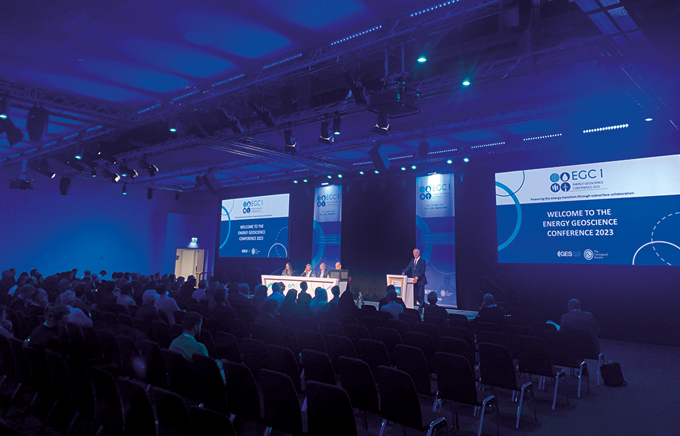Bernie Vining and Angus Montgomery recall the highly acclaimed Energy Geoscience Conference, discussing the ways in which geoscientists are driving the energy transition through subsurface collaboration.

A gas platform and wind turbines in the Irish Sea, viewed from Cumbria, UK. As we transition away from fossil fuels, we must repurpose the subsurface, keeping in mind competing uses
he energy transition is underway. Geoscientific knowledge is essential to achieving net zero, so to accelerate efforts a new conference series, The Energy Geoscience Conference was launched to facilitate collaboration between those working across the energy mix, in both traditional exploration, alternative and renewables geoscience. The first conference in the series (EGC1), Powering the energy transition through subsurface collaboration, took place in Aberdeen in May 2023. A true highlight in the energy industry calendar, and a sellout with over 600 attendees of all career stages from across academia and industry, the meeting sought to address technical challenges and support geoscientists working to explore and develop the energy supplies, storage and sequestration facilities demanded by the energy transition.
The EGC series builds on a heritage of 50 years of Petroleum Geology Conferences – a series that began in the mid-1970s, when the North Sea was an emerging world-class petroleum province, through the 1990s, when the North Sea was the place to be, and in later years with widening geographic scope that reflected the growing maturity of the North Sea province. These conferences were landmark events and EGC is building on this legacy by re-framing the geoscience narrative to focus on the geoscience needs for the challenges of today and tomorrow. The topics explored at EGC1 – via Plenary sessions, panel discussions and debates, as well as in talks and poster sessions – were diverse, including exploration, carbon capture and storage, emerging geothermal energy, natural hydrogen and helium, offshore wind, and nuclear waste disposal.
Changing narrative
North Sea hydrocarbon production is in decline, but after 50 years of exploration, appraisal and production, an unprecedented level of knowledge and learnings remain. With such a wealth of UK-grown technical skill now being ‘decommissioned’, it is no shock that a pivot to solve the challenges of a low-carbon future is already underway. There is a wealth of crossover methodologies and technologies to be shared, leveraging experiences and expertise from the petroleum sector to provide low-carbon solutions.
For example, John Underhill (University of Aberdeen) offered an introduction to the application of play-based exploration methods within the carbon capture and storage space. In the same way in which hydrocarbon prospects have been defined traditionally, a CO2 storage reservoir can be graded using a Common Risk Segment mapping approach by superimposing a combination of risk maps for the reservoir, seal, trap and overburden. It is critical to also include non-technical parameters in this approach. For example, legacy well-integrity and competition for offshore areas (such as from offshore wind, fishing, and marine protections) contribute non-geological components of complexity to the identification of CO2 sinks. This example clearly demonstrates the important role high-resolution datasets, developed over the last half-century, play in the UK’s pathway to decarbonisation.
At EGC1, novel, more unconventional applications of play-based techniques included: CO2 storage within the Moray Firth Basin (Douglas Watson, University of Aberdeen) and the Southern North Sea (Martha Vinhais Gutierrez, Heriot-Watt University); hydrogen storage potential in the Southern North Sea (Sjastri Hansen, Royal Holloway University); assessments of geothermal systems (Astrid Jonet, AspenTech); and native hydrogen exploration (Carolina Olivares, CGG). The diverse range of industries adopting play-based exploration methods clearly indicates that the pivot of skilled energy geoscientists towards the low-carbon sector is gaining momentum.
In total, only a quarter of the conference presentations had an oil and gas focus (a striking observation for a conference held in Aberdeen, once labelled the ‘oil capital of the world’). However, it is important to recognise that petroleum will remain a significant part of the energy mix in the coming years and the North Sea will play its part. For example, one theme explored at the meeting was how to revisit mature areas with new ideas. Graham Goffey (Soliton Resources) showed how modelling the evolution of welded salt diapirs can provide new insights into stress regimes in the Isolde prospect in the Central North Sea, while Jose Luis Megchun Rivera (TotalEnergies) discussed how leveraging new technologies, in this case ocean bottom node seismic, together with complex extended well drilling of more than 6 km, in a high-temperature, high-pressure regime, can aid prospect generation in mature areas, using the example of the Alwyn East exploration well in the northern North Sea.
From a global perspective, and at a significantly larger regional scale, Bryan Cronin (Tullow) highlighted the importance of tectono-stratigraphic basin evolution studies in the exploration for deep-water slope stratigraphic traps in the Late Cretaceous plays of the Guyana-Suriname and Cote d’Ivoire-Ghana margins; two global petroleum hot-spots.
Carbon capture and storage
While a significant amount of high-quality research is being performed, the pace of knowledge deployment is concerning. This was exemplified by the panel discussion entitled ‘Carbon storage: are barriers to successful implementation technical, regulatory, political or commercial?’. The panel consensus was that there are minimal technical barriers; it is the integration of technologies into a single process taking CO2 from a brownfield manufacturing plant or power station to injection into subsurface reservoirs that is challenging. However, the critical barrier is establishing the right regulatory and commercial framework for attracting capital into the industry – one with many project opportunities. Without the security of 20-year plus revenue streams, these projects will not happen.

The P&J Live conference centre in Aberdeen provided an excellent venue
Emerging resources
A series of talks on ‘mine water geothermal’ addressed the energy needs of residential and commercial heating in the UK. Mine waters are a potential heat source for cities sitting above disused collieries – of which there are 23,000 in the UK! Alison Monaghan (BGS) discussed data from the Geoenergy Observatory in Glasgow (see page 16), while Charlotte Adams (The Coal Authority) gave an overview of the Gateshead Mine Heat Scheme in northeast England, the largest mine water heat network in Great Britain, which went live in March 2023. The heat from mine working stored 150 m beneath Gateshead is delivered to a range of buildings, including offices and council-owned homes. These projects are underpinned by massive coalfield datasets extending back many decades and even centuries. It will be interesting to see further results, particularly surrounding commercialisation of this research area.
Fascinating presentations on the exploration for natural hydrogen and helium demonstrated further crossover in methodologies from the oil and gas sector. Hydrogen is produced from water radiolysis of igneous rocks or via serpentinisation of ultramafic rocks, while helium is produced via the radioactive decay of uranium and thorium in Earth’s crust. Groundwater transport can lead to accumulation in sedimentary basins and Max Norman (CGG) explained how helium systems can be defined similarly to petroleum systems. Rūta Karolytė (University of Oxford) gave evidence for the co-occurrence of hydrogen and helium in the Witwatersrand Basin, South Africa, while Lorna Blaisse (HeliumOne Global) provided insights on helium exploration activity in Tanzania.
An exciting time
The diversity of topics covered during the conference highlighted the evolving role of the geoscientist. It is an exciting time to be an energy geoscientist, and the meeting showcased some incredible talent and unprecedented collaboration. However, there is a disconnect between the vibrant forum of the conference, and the advanced collapse of UK geoscience education. It was heartening to see that solutions are being rigorously pursued, as shown in the talk ‘Be an Energy Geoscientist; Make a Difference’ (Bernie Vining, Royal Holloway, University of London; Jonathan Redfern, University of Manchester; John Underhill, University of Aberdeen; Joe Court, Shell) as well as via the Energy Transition Centre for Masters’ Training (www.energy-transition.ac.uk), a UNESCO International Geoscience Programme and a collaboration between UK universities and industry that promotes access to resources and training for the next generation of geoscientists, and the GeoNetZero Centre for Doctoral Training (www.geo-net-zero.hw.ac.uk), which provides a programme of PhD research and training tailored towards the energy transition and challenge of reaching net zero.
The outstandingly successful conference highlighted the shifting direction and pace of the energy transition. The use of crossover technologies was readily apparent and encouraged, leveraging expertise and experiences to meet the challenges of today and tomorrow. The recurring theme of revisiting old problems with new ideas was clearly in evidence. The talks are available online to delegates, while a Proceedings Volume (in preparation) will provide a useful resource to delegates and those unable to attend, as well as for university geoscience departments looking to update their curricula with the latest research.
Like the Petroleum Geology Conferences, the Energy Geoscience Conference series will follow an evolutionary pathway through the energy transition, leading the way toward a low-carbon future.
Prof Bernie Vining
Royal Holloway, University of London, UK
Angus Montgomery
Azuli International
Other contributors: Craig Allsop, University of Strathclyde; Graham Goffey, Soliton Resources; Lucinda Layfield, Equinor; Rory McArthur, ERCE; Holly-Marie Owen, ERCE; Ashley Price, Royal Holloway, University of London; Christian Thomas, ExxonMobil; Thomas Twigg, ExxonMobil; Hamish Wilson, Azuli International.
This article is reposted from an original article published by Geoscientist magazine.
KeyFacts Energy News: Energy Transition
 KEYFACT Energy
KEYFACT Energy